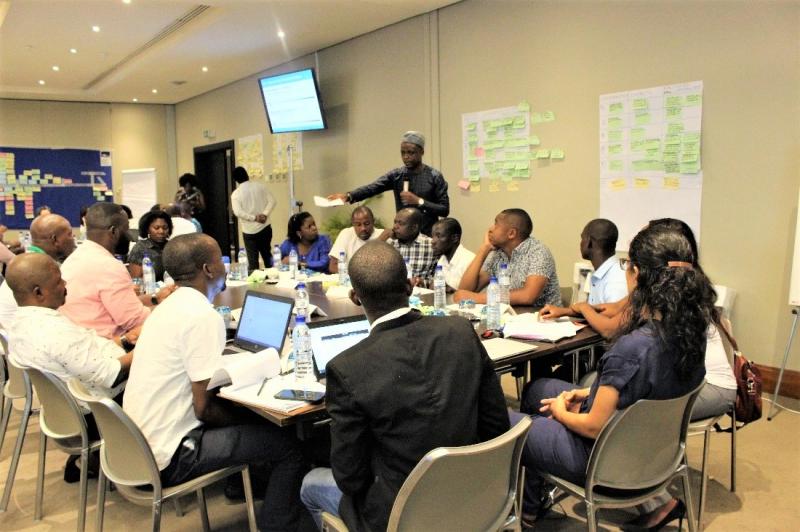
Learning from Cyclones Idai and Kenneth to improve the response to natural disasters and emergencies in Mozambique
December 18, 2019
African Region
Mozambique
Mozambique conducted an after action review following recent devastating cyclones to learn lessons from the response and be better prepared for future natural disasters and emergencies.
The after action review (AAR) was conducted in the first week of November 2019 to critically analyze the health sector’s contribution to the multisectoral response and coordination during and after Cyclones Idai and Kenneth that hit the country in March and April 2019. WHO developed resources and tools
[1]
to support such AARs following natural disaster response.
[[{"fid":"3927","view_mode":"default","fields":{"format":"default","alignment":"center","field_file_image_alt_text[und][0][value]":false,"field_file_image_title_text[und][0][value]":false,"external_url":""},"type":"media","field_deltas":{"1":{"format":"default","alignment":"center","field_file_image_alt_text[und][0][value]":false,"field_file_image_title_text[und][0][value]":false,"external_url":""}},"link_text":null,"attributes":{"class":"media-element file-default media-wysiwyg-align-center","data-delta":"1"}}]]
The AAR allowed the country to do a root cause analysis to assess what is behind the challenges and successes encountered during the response and to identify areas for improvement and good practices at all levels of the health system. Key response functions of leadership and partner coordination, planning and information management, health operations and technical expertise, support and logistics operations and finance and administration were examined.
WHO is now working with the government of Mozambique through the Country Office in the implementation of the AAR findings and to follow-up progress in improving health system resiliency.
Mozambique is prone to recurring natural disasters, including floods, tropical storms, droughts and earthquakes. About 60 percent of the population lives along the coast and is vulnerable to cyclical tropical storms, with over 46 cyclones and floods occurring in the last 30 years.
Cyclone Idai made landfall near Beira City on the night of March 14th, 2019, with devastating results.
There were 1,641 injuries and 602 deaths reported, and the declaration of a State of National Emergency. Some 1,514,445 people were affected by the cyclone in Sofala Province (Beira City and the Districts of Dondo, Buzi, Nhamatanda, Chibabava and Muanza), Mutarara in Tete Province; City of Chimoio, Vanduzi, Macate, Sussundenga, Mossurise, Chimoio and Gondola in Manica Province; and Chinde, Nicoadala, Maganja da Costa and Namacura in Zambezia Province.
About 90% of Beira City's infrastructure was destroyed, leading to the total or partial loss of many health facilities, schools, churches and industries, disruption of access and trade, water and energy supply cuts, crop destruction, and more than 100,000 displaced people in the country.
Mozambique was struck hard again on April 25th, when Cyclone Kenneth caused destruction in Cabo Delgado Province (Ibo, Quissanga, Macomia, Pemba and Mecufi Districts) with 286,000 people affected, 94 injured, 45 deaths and damaged health infrastructure, schools and access roads.
Due to degradation of sanitation, cholera epidemics followed the cyclones in Sofala Province (cumulative total of 6,771 cases and 8 deaths, case fatality rate = 0.12%) and Cabo Delgado Province (282 cases and no deaths).
The AAR conducted in November to analyze the health sector’s contribution to the response brought together all stakeholders from the central and district levels, including local NGOs and partners that were involved.
[[{"fid":"3928","view_mode":"default","fields":{"format":"default","alignment":"center","field_file_image_alt_text[und][0][value]":false,"field_file_image_title_text[und][0][value]":false,"external_url":""},"type":"media","field_deltas":{"2":{"format":"default","alignment":"center","field_file_image_alt_text[und][0][value]":false,"field_file_image_title_text[und][0][value]":false,"external_url":""}},"link_text":null,"attributes":{"class":"media-element file-default media-wysiwyg-align-center","data-delta":"2"}}]]
The benefits for conducting the AAR were 1) to build consensus on issues for follow-up and actions necessary to improve preparedness for future natural disasters, 2) to allow documentation of lessons learned and best practices that emerged from the response, 3) to allow cross-sectoral learning amongst all stakeholders and sectors involved in the response, 4) to use the AAR as an advocacy tool for domestic financing to support the implementation of AAR findings. The AAR will allow the country to strengthen capacity for preparedness and response by addressing the areas for improvement and to institutionalize the best practices.